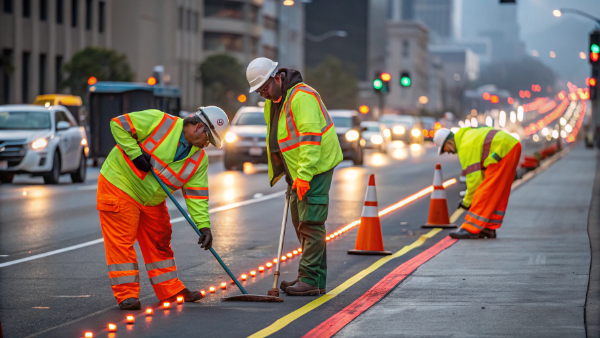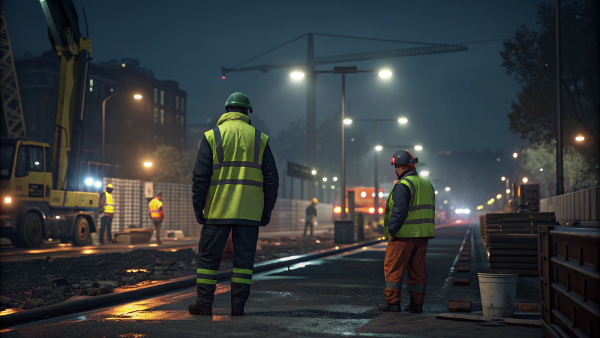Tired of your crew getting soaked in their "rain gear"? This compromises safety and productivity. The right choice in materials and construction is the key to keeping them truly dry.
To select hi-vis rain gear that keeps your crew dry, look for materials with a waterproof rating of at least 10,000mm, such as PVC or PU-coated polyester. Sealed seams, breathable membranes, storm flaps, and ANSI/ISEA 107 compliance are essential for complete protection and safety.
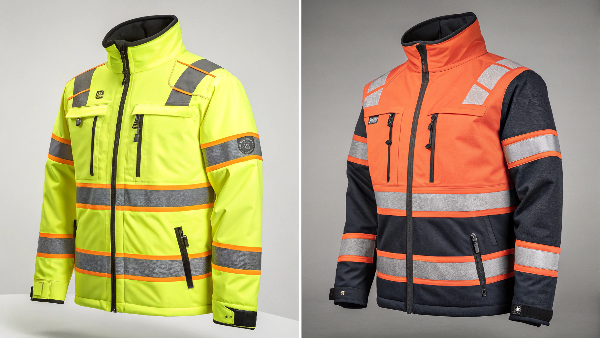
Choosing the right gear might seem simple, but many factors determine true waterproof performance. Getting it wrong leads to uncomfortable, unhappy, and unsafe workers. I've seen clients struggle with this for years, which is why understanding the details is so important. Let's break down exactly what you need to look for, from materials to maintenance, so you can make an informed decision for your team.
How can your crew stay dry while working in the rain?
Rain seeps through gear, making work miserable and dangerous. Wet clothing leads to cold stress, sickness, and a loss of focus. Strategic layering and proper gear selection is the answer.
The key is wearing the right layers. Start with a moisture-wicking base layer1, add an insulating mid-layer2 for warmth, and top it with high-quality, fully sealed waterproof outerwear3. This combination manages sweat from the inside and blocks rain from the outside.
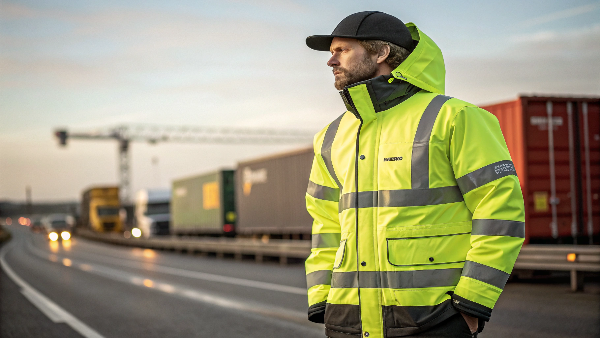
Staying dry is about managing two sources of moisture: rain from the outside and sweat from the inside. A single jacket can't do it all; you need a system. I always advise my clients, like Danny in California who outfits crews in diverse weather, to educate their users on the three-layer system. It is the most effective strategy for all-day comfort and safety. Each layer has a specific job, and when they work together, the wearer stays dry and comfortable.
The Three-Layer System for Dryness
| Layer | Purpose | Material Examples |
|---|---|---|
| Base Layer | Wicks sweat away from your skin. | Synthetic fabrics (Polyester, Polypropylene), Merino Wool |
| Mid-Layer | Insulates by trapping body heat. | Fleece, Down, Synthetic Insulation |
| Outer Layer | Blocks wind and rain. | PU-coated Polyester, PVC, Laminates (e.g., Gore-Tex) |
Your outer layer, the rain gear itself, must have the right features. Look for fully taped or welded seams, as water will penetrate stitch holes. An adjustable hood, storm flaps4 over zippers, and adjustable cuffs create a seal against the elements. We design our Vissafety rain jackets with these non-negotiable features because we know that's the only way to guarantee a crew stays dry on the job.
How do you re-waterproof your rain gear?
Your expensive rain gear is starting to "wet out" and leak. Replacing it is costly and wasteful, but you cannot compromise on your crew's safety. A simple re-waterproofing process5 can restore its performance.
First, clean the garment with a specialized tech wash. Then, apply a spray-on or wash-in Durable Water Repellent (DWR) treatment6. Tumble drying on low heat, if the care label allows, often helps to set the new DWR coating.
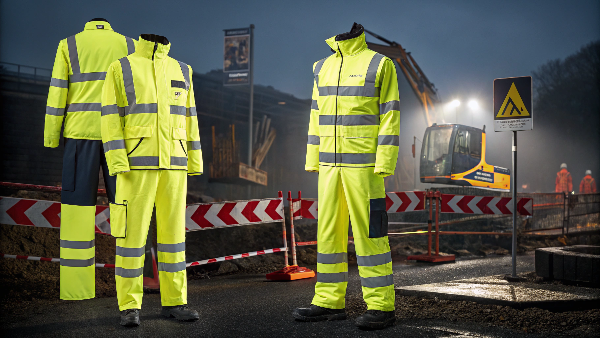
Over time, the factory-applied DWR coating that makes water bead up and roll off gets worn down by dirt, abrasion, and washing. Re-applying it is a critical maintenance step that extends the life of your investment. It's a simple process that anyone can do. Before you begin, always check the garment's care instructions, as some materials have specific requirements. We ensure our fabrics can handle these maintenance cycles.
Step-by-Step Re-Waterproofing Guide
- Clean: Wash the garment in the washing machine using a technical cleaner specifically designed for waterproof apparel. Regular detergents contain surfactants that can leave behind residues, which attract water and impair breathability.
- Treat: While the garment is still damp, apply the DWR restoration product. You have two main options:
| Treatment Type | Pros | Cons |
|---|---|---|
| Spray-On DWR | Allows for targeted application on high-wear areas (shoulders, cuffs). Doesn't affect a garment's wicking liner. | Can be messy to apply and requires even coverage. |
| Wash-In DWR | Easy and provides excellent, even coverage. | Coats the entire garment, including any internal liners, which can slightly reduce breathability. |
- Cure: Many DWR treatments are heat-activated. If the care label permits, tumble dry the garment on a low or medium heat setting for 20-30 minutes. The heat helps the DWR bond to the fabric, restoring its water-shedding performance.
How can you avoid sweating excessively in rain gear?
You put on rain gear to stay dry from the rain, but within an hour, you're soaked in your own sweat. This clammy feeling is uncomfortable and can lead to chills. Prioritizing breathable materials and ventilation is the only solution.
To avoid sweating, choose rain gear made from breathable materials with a high Moisture Vapor Transmission Rate (MVTR)7. Look for features like pit zips8, mesh liners, and back vents9 that allow heat and moisture to escape. Proper layering is also crucial.
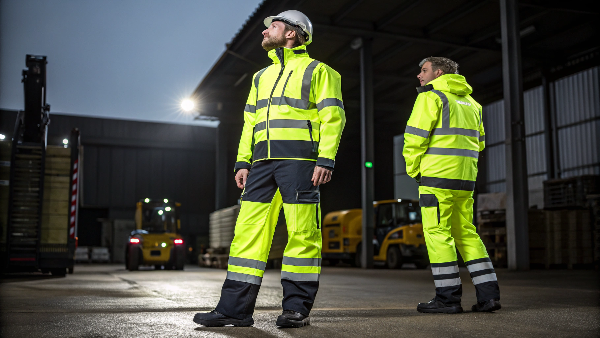
The feeling of being "wet from the inside" is a common and dangerous problem. When sweat can't escape, it saturates your inner layers, eliminating their insulating properties. This can lead to rapid body temperature loss, even in mild weather. That's why we don't just focus on keeping rain out; we engineer our garments to let sweat vapor out. This concept is called breathability. It's measured by how much water vapor can pass through a square meter of fabric in 24 hours (MVTR). A higher number is better.
Key Features for Better Breathability
| Feature | How It Works | Best For |
|---|---|---|
| Pit Zips | Zippers under the arms that open to vent heat and moisture directly. | High-exertion tasks; allows for rapid cooling. |
| Back Vents | An overlapping flap on the back yoke that allows heat to rise and escape. | Constant, passive ventilation for moderate activity. |
| Mesh Liners | Creates an air gap between the waterproof shell and your body, improving air circulation. | General comfort and preventing a clammy feeling. |
| Two-Way Zippers | Allows the jacket to be unzipped from the bottom for ventilation without fully opening it. | Versatility in changing conditions. |
When we co-developed a new lightweight jacket with our client Danny, this was his top concern for his crews in hot climates. We used a highly breathable PU-coated fabric10 and incorporated both back vents9 and a mesh liner to maximize airflow, solving his problem.
Is there a raincoat that doesn't make you sweat?
Every raincoat you've tried seems to trap sweat, making you feel wet anyway. It makes you wonder if a truly "non-sweat" raincoat is just a myth. The answer lies in advanced material science, but it comes with trade-offs.
No raincoat can completely eliminate sweat, especially during hard work. However, jackets with advanced breathable membranes11 (like high-end PU or ePTFE) and mechanical vents come very close. They work by allowing tiny sweat vapor molecules out while blocking larger water droplets.
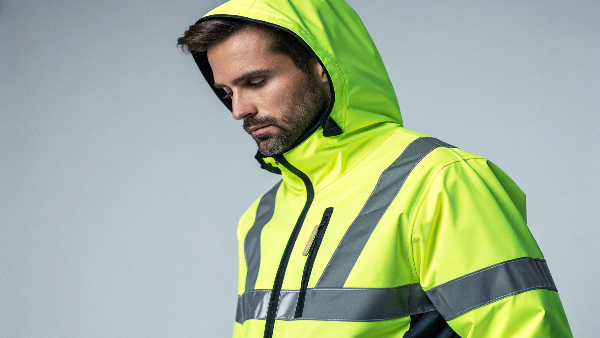
The ultimate goal of high-performance rainwear is to be totally waterproof and totally breathable. Unfortunately, these two properties are often in opposition. The more of a barrier you create to stop water from getting in, the harder it is to let water vapor out. The secret is in the fabric's membrane.
The Science Behind Breathable Fabrics
There are two primary types of breathable waterproof membranes we use in our products, depending on the client's needs for performance and cost.
-
Microporous Membranes: These are films stretched to create billions of microscopic pores per square inch. The pores are thousands of times smaller than a water droplet (so rain can't get in) but hundreds of times larger than a water vapor molecule (so sweat can get out). This is very effective but can be more expensive.
-
Hydrophilic Membranes12: These are solid, non-porous films that work through chemical diffusion. Water vapor molecules are attracted to the membrane, move through its molecular structure, and are pushed to the outside where humidity is lower. PU coatings are a perfect example.
Finding the right balance is our specialty. For a road crew working in the summer heat, we'd recommend a highly breathable microporous laminate. For a supervisor who is less active, a high-quality PU-coated fabric10 provides an excellent balance of waterproofness, breathability, and value.
Is polyurethane really better than PVC for rain gear?
You see Polyurethane (PU) and Polyvinyl Chloride (PVC) everywhere, but what's the right choice? Making the wrong call can mean outfitting your crew in stiff, uncomfortable, or non-breathable gear that they refuse to wear. The better choice depends on your priority: worker comfort or raw durability.
For most applications, Polyurethane (PU) is better. It is more flexible, lightweight, and breathable than PVC. While PVC is very waterproof and cheap, it is non-breathable and can become stiff and crack in the cold. For worker comfort, PU is superior.
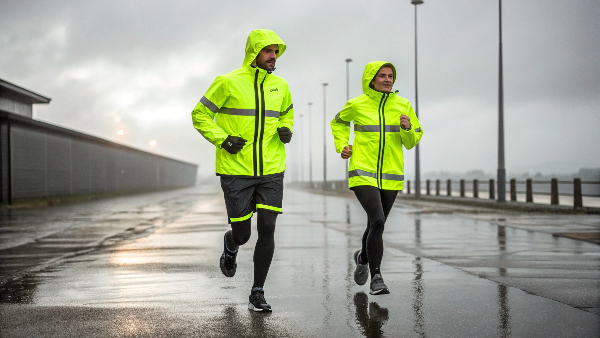
I get this question all the time from procurement managers. For years, PVC was the standard because it was cheap and 100% waterproof. But we've learned that if a worker is sweating inside a non-breathable plastic bag, they aren't truly dry or safe. This is why the industry has shifted heavily towards PU-coated fabric10s. It provides a much better user experience, which leads to better compliance with PPE rules. A jacket is useless if your crew won't wear it.
PU vs. PVC: A Head-to-Head Comparison
| Feature | Polyurethane (PU) | Polyvinyl Chloride (PVC) |
|---|---|---|
| Breathability | Good to Excellent | None |
| Flexibility | Excellent, even in cold | Poor; becomes stiff in cold |
| Weight | Lightweight | Heavy and bulky |
| Durability | Good; resists tearing | Excellent; resists abrasion & chemicals |
| Cost | Moderate | Low |
| Comfort | High; soft and quiet | Low; can feel like a plastic bag |
For 90% of our clients in construction, logistics, and utilities, we recommend PU-coated polyester13. The investment pays off in worker comfort, safety from heat stress, and gear that lasts. PVC has its place, but it's a very specific one.
What is the absolute best material for rain gear?
With so many options—Polyester, Nylon, PU, PVC, proprietary laminates—picking the single "best" one is confusing. Making the wrong choice leads to wasted money, unhappy workers, and gear that fails in the field. The 'best' material is always the one that best matches the job.
There is no single best material; it depends on the application. For high-exertion work, a breathable, PU-laminated polyester is ideal. For stationary work or tasks with chemical splash hazards, heavy-duty PVC14 is a better choice. The key is matching the material to the work environment.
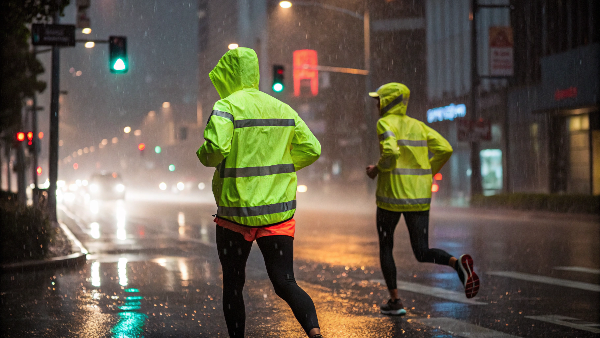
As a manufacturer with over 20 production lines, we can create rain gear from almost any material. Our job isn't to push one fabric but to help our clients choose the perfect one for their needs. A roofer working under the summer sun has very different needs from a chemical plant worker or a site surveyor. Defining the job requirements first is the most important step. We help our clients do this by asking about exertion level, duration of use, abrasion risk, and specific hazards.
Matching Materials to Job Requirements
| Industry / Task | Recommended Material | Key Benefits |
|---|---|---|
| Road Construction / Paving | 300D PU-Coated Oxford Polyester15 | High breathability, excellent durability, high visibility. |
| Logistics / Warehouse | 150D PU-Coated Polyester | Lightweight, flexible for movement, good breathability. |
| Chemical Plant / Hazmat | PVC on Polyester Scrim | Impervious to liquids, high chemical resistance, easy to decontaminate. |
| Site Inspection / Supervisor | Lightweight PU or 2.5L Laminate | Very breathable, packable, professional look. |
| Emergency Services | High-Spec Laminate (e.g., ePTFE) | Maximum waterproof/breathable performance, blood-borne pathogen resistance. |
Understanding these trade-offs is crucial. Our professional sales team is trained to walk you through this process, ensuring you get a product that delivers real value and safety, not just a low upfront cost.
So, which one is better: PU or PVC?
You need to make a quick decision between PU and PVC for your next bulk order. The technical details can be overwhelming, and you just need the bottom line. Here’s the simple answer for most B2B buyers.
For most high-visibility workwear, Polyurethane (PU) is the better choice. Its combination of breathability, flexibility, and lighter weight provides far greater worker comfort and helps prevent heat stress. PVC's main advantage is its low cost for low-exertion tasks.
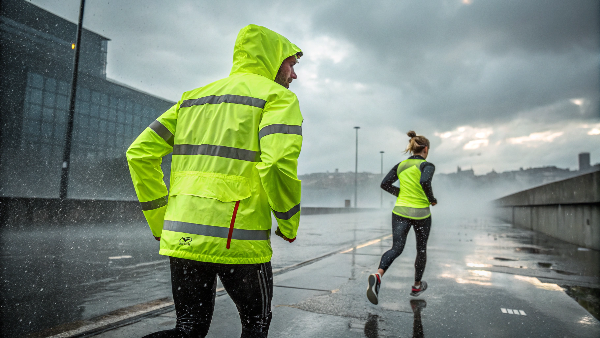
It's important to understand that most modern rainwear isn't made from pure PU or PVC plastic. Instead, we use what's called a coated fabric. We start with a strong base fabric, typically a woven polyester, and apply a thin layer of PU to the inside. This gives you the best of both worlds.
The Rise of PU-Coated Fabrics
This composite construction is standard in high-quality rainwear for a reason.
- The Base Fabric (e.g., 300D Oxford Polyester): This woven outer fabric provides the garment's structure, strength, and resistance to tears and abrasion. The "D" stands for Denier, a measure of thread thickness; a higher number like 300D is more robust than a lighter 150D.
- The PU Coating (The Barrier): The thin layer of polyurethane applied to the inner surface is what makes the fabric waterproof and breathable. It seals the gaps in the woven polyester while allowing sweat vapor to pass through.
By adjusting the thickness of the PU coating and the denier of the base fabric, we can precisely engineer the material for different perform
-
A moisture-wicking base layer is essential for keeping sweat away from your skin, enhancing comfort. ↩
-
Learn how an insulating mid-layer helps retain body heat, crucial for comfort in cold conditions. ↩
-
Identifying key features ensures you select outerwear that effectively blocks rain and wind. ↩
-
Discover how storm flaps enhance the waterproofing of jackets by covering zippers and openings. ↩
-
Re-waterproofing extends the life of your gear, saving money and ensuring ongoing protection. ↩
-
Understanding DWR treatments helps maintain your gear's waterproof performance over time. ↩
-
MVTR is key to choosing breathable rain gear that prevents sweat buildup and discomfort. ↩
-
Pit zips provide essential ventilation, making them ideal for high-exertion activities in rain. ↩
-
Back vents allow heat to escape, enhancing comfort during prolonged wear in wet conditions. ↩ ↩
-
Coated fabric combines strength and waterproofing, ensuring your rain gear performs well in the field. ↩ ↩ ↩
-
Learn how breathable membranes enhance comfort by allowing sweat to escape while keeping rain out. ↩
-
Understanding hydrophilic membranes helps you choose the right rain gear for your needs. ↩
-
PU-coated polyester offers a balance of breathability and waterproofing, ideal for various tasks. ↩
-
Heavy-duty PVC is ideal for specific tasks requiring high chemical resistance and durability. ↩
-
This material offers excellent durability and breathability, making it suitable for tough conditions. ↩

